May 29, 1940 – Nebraska’s First Oil Well –
After more than a half century of dry holes, Nebraska’s first commercial oil well was completed near Falls City in the southeastern corner of the state. Eager to join other states benefiting from tax revenue gained from petroleum, Nebraska lawmakers had offered a $15,000 bonus for the first well to produce 50 barrels of oil daily for two months.

Although Nebraska oil production began in 1940 in Richardson County in the southeastern corner of the state, most production would come from western counties.
Pawnee Royalty Company completed the Bucholz No. 1 well with production of about 170 barrels of oil a day in its first 60 days. The well was about five miles east of a “vein of petroleum” first reported by geologists in 1883.
Learn more in First Nebraska Oil Well.
May 30, 1911 – First Indianapolis 500 takes Seven Hours
The first Indianapolis 500-mile race began with 40 cars; only 12 finished the 1911 test of endurance and automotive technology. The winner averaged almost 75 mph after about seven hours of racing.
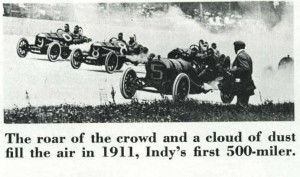
All of the cars except the winner had a mechanic to manually pump oil. More than 60,000 watched the first race.
All cars except the winning No. 32 Marmon Wasp had two seats because drivers traveled with “riding mechanics,” who manually pumped oil. Ray Harroun, driver of the Marmon Wasp, would also develop a kerosene carburetor. “Let the fuel people fight it out amongst themselves, I’ll have a car soon that will burn anything they send,” he declared.
A decade before the first Indy 500, gasoline powered less than 1,000 of the 4,200 cars sold in America (see Cantankerous Combustion – 1st U.S. Auto Show).
May 30, 1987 – Million Barrel Museum opens in Monahans, Texas
The Million Barrel Museum opened on a 14.5-acre site in Monahans, Texas. The museum’s main attraction is a large elliptical oil storage tank built in 1928 to store Permian Basin oil.
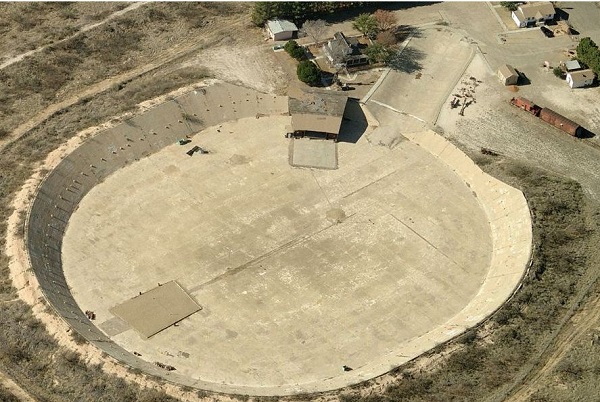
The Monahans Million Barrel Museum’s 525 foot by 422 foot concrete foundation once included a wooden roof. The structure, built to store Permian Basin oil in 1928, became a Monahans water park for one day in 1958.
The experimental concrete tank — 525 feet by 422 feet — was designed to hold more than a million barrels of oil. The highly productive West Texas region lacked oil pipelines. The tank’s 30 foot earthen walls sloped at a 45-degree angle and were covered in concrete. It included a roof made of California redwood.
Repeated efforts could not stop oil from leaking at seams. Shell eventually abandoned the giant structure, which would be patched to briefly become a water park in the 1950s…until it leaked again.
Learn more in Million Barrel Museum.
June 1, 1860 – First Book about Oil published
Less than 10 months after Edwin L. Drake completed the first commercial U.S. oil well at Titusville, Pennsylvania, Thomas A. Gale published an 80-page pamphlet many regard as the first book about America’s petroleum resources. The Wonder of the Nineteenth Century: Rock Oil in Pennsylvania and Elsewhere described the advantages of the new fuel source for kerosene lamps.
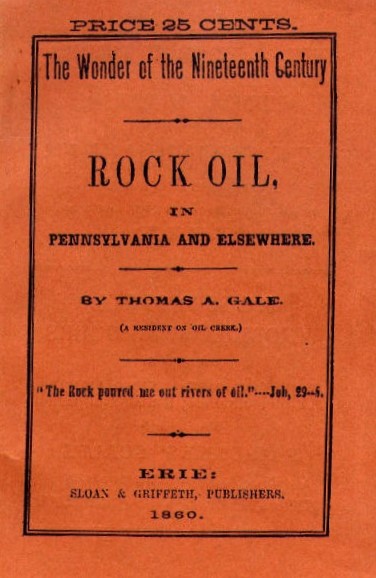
An 80-page pamphlet by Thomas Gale published in 1860 described the beginning of the petroleum age that began one year earlier at Titusville, Pennsylvania.
“Those who have not seen it burn, may rest assured its light is no moonshine; but something nearer the clear, strong, brilliant light of day,” Gale declared in his pamphlet, which sold for 25 cents. Only three original copies were known to exist in 1952, when Ethyl Corporation of New York republished The Wonder of the Nineteenth Century.
Learn more in First Oil Book of 1860.
June 1, 1899 – Giant California Oilfield discovered at Kern River
After others found signs of oil northeast of Bakersfield, California, Milton and Horace McWhorter drilled the region’s first commercial well. Their well revealed the 10,750-acre Kern River oilfield on the eastern edge of the southern San Joaquin Valley — the first of many contiguous fields to be found in Kern County.
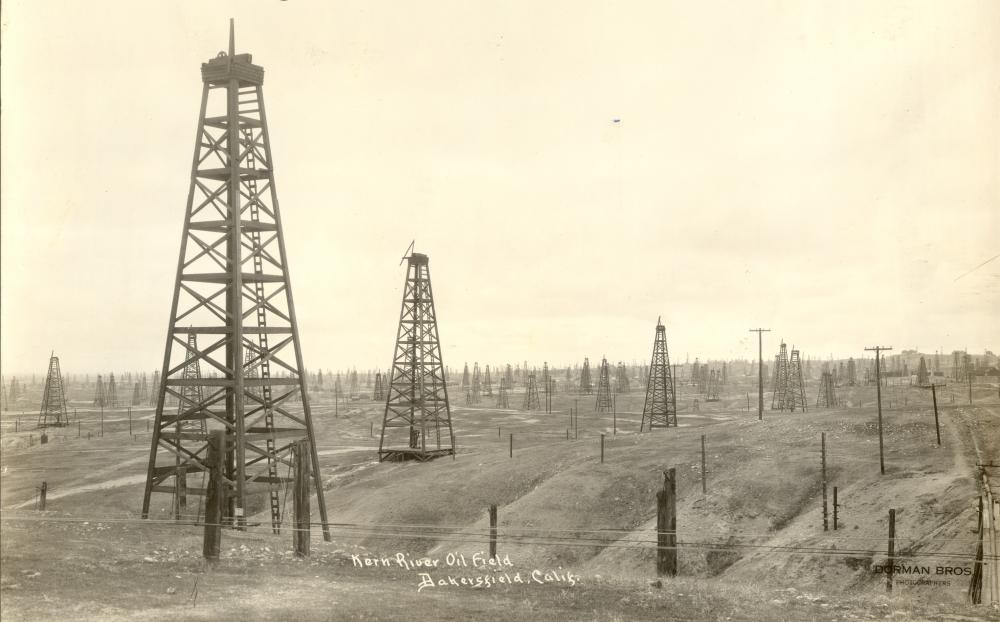
Discovered in 1899, California’s prolific Kern River field was the first of many giant Kern County oilfield discoveries. Circa 1910 photo courtesy Kern County Oil Museum.
A drilling boom expanded the state’s petroleum industry by attracting major oil companies (and briefly, retired lawman Wyatt Earp). Kern County’s 8,000 square miles in 2020 accounted for 70 percent of California’s oil and more than 90 percent of its natural gas.
Learn more California oil history by visiting the the West Kern Oil Museum and the Kern County Museum.
June 1, 1909 – Secret Test of Revolutionary Drill Bit
A drilling crew secretly tested a dual-cone roller rock bit at Goose Creek near Galveston Bay, Texas. “In the early morning hours of June 1, 1909, Howard Hughes Sr. packed an experimental bit into the trunk of his car and drove off into the Texas plains,” noted Gwen Wright in a 2006 episode of History Detectives. The coned, roller bit would soon make traditional rotary fishtail bits obsolete.
“When the Hughes twin-cones hit hard rock, they kept turning, their dozens of sharp teeth (166 on each cone) grinding through the hard stone,” the PBS show explained. Hughes and partner R. Carlton “Carl” Baker formed Baker Hughes Tools Company (see Carl Baker and Howard Hughes).
June 1, 1940 – Dallas Artist depicts Life in Texas Oilfields
Artist Jerry Bywaters of Paris, Texas, exhibited his newly painted Oil Field Girls in the Fine Arts Palace of San Francisco’s Golden Gate International Exposition. The 1940 painting of two young women in a West Texas oilfield and its companion piece, Oil Rig Workers (Roughnecks), would become among his best known works.
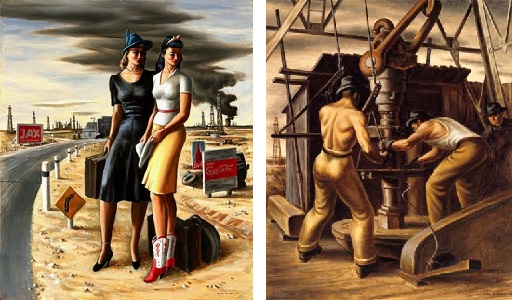
Jerry Bywaters (1906-1989) painted Oil Field Girls and the Oil Rig Workers in 1940. According to the Blanton Museum of Art, Austin, Texas, Bywaters’ Oil Field Girls, “is a work of incredible moral complexity.”
Bywaters was a member of the Dallas Nine, a group of young painters in the 1930s, “who helped establish a regional artistic identity for Texas art,” according to the Blanton Museum of Art at the University of Texas, which acquired Oil Field Girls in 1984.
June 3, 1979 – Bay of Campeche Oil Spill
Drilling in about 150 feet of water, the semi-submersible rig Sedco 135 suffered a devastating blowout 50 miles off Mexico’s Gulf Coast. The state-owned company Pemex well spilled 3.4 million barrels of oil before being brought under control nine months later.
Considering the size of the spill, its environmental impact was limited, according to a 1981 report by the Coordinated Program of Ecological Studies in the Bay of Campeche.
“Nature played the biggest role in attacking the slicks as they floated across the Gulf. Ultraviolet light broke down the oil as it crept toward land, the reported noted. “So did oil-eating microorganisms. Hot temperatures spurred evaporation.”
June 4, 1872 – Pennsylvania Oilfields bring Petroleum Jelly
A young chemist living in New York City, Robert Chesebrough, patented “a new and useful product from petroleum,” which he named “Vaseline.” His patent proclaimed the virtues of this purified extract of petroleum distillation residue as a lubricant, hair treatment, and balm for chapped hands.
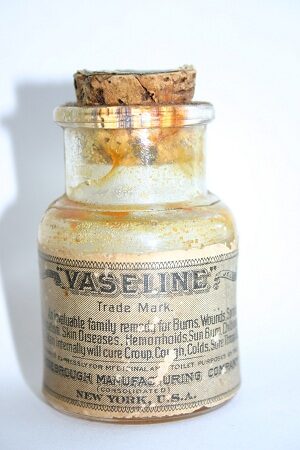
Robert Chesebrough consumed a spoonful of Vaseline each day and lived to be 96 years old. Photo courtesy Drake Well Museum.
When the 22-year-old chemist visited the new Pennsylvania oilfields in 1865, he had noted that drilling was often confounded by a paraffin-like substance that clogged the wellhead. Drillers used the “rod wax” as a quick first aid for abrasions.
Chesebrough returned to New York City and worked in his laboratory to purify the oil well goop, which he first called “petroleum jelly.” Female customers would discover that mixing lamp black with Vaseline made an impromptu mascara. In 1913, Mabel Williams employed just such a concoction, and it would lead to the founding of a major cosmetic company.
Learn more in The Crude History of Maybel’s Eyelashes.
June 4, 1892 – Flood and Fire devastate Pennsylvania Oil Region
After weeks of thunderstorms in Pennsylvania’s Oil Creek Valley, the Spartansburg dam on Oil Creek burst, sending torrents of water that killed more than 100 people and destroyed homes and businesses in Titusville and Oil City. The disaster was compounded when fires broke out.

Titusville, Pennsylvania, residents used the “Colonel Drake Steam Pumper” during the great flood and fire of 1892. Photo courtesy Drake Well Museum.
“This city during the past twenty-four hours has been visited by one of the most appalling fires and overwhelming floods in the history of this country,” reported the New York Times from Oil City. Oilfield photographer John Mather’s studio and 16,000 glass-plate negatives were destroyed.
Learn more in Oilfield photographer John Mather.
June 4, 1896 – Henry Ford test drives “Quadricycle”
Driving the first car he ever built, Henry Ford left a workshop behind his home on Bagley Avenue in Detroit, Michigan. He had designed his “Quadricycle” in his spare time while working as an engineer for Edison Illuminating Company. Ford chose the name because his handmade, 500-pound “horseless carriage” ran on four bicycle tires. Inspired by advancements in gasoline-fueled engines, he founded Henry Ford Company in 1903.
June 4, 1921 – First Petroleum Seismograph tested
A team of earth scientists tested an experimental seismograph machine on a farm three miles north of Oklahoma City and determined it could accurately map subsurface structures. Led by Prof. John C. Karcher and W.P. Haseman, the team from the University of Oklahoma proved that reflection seismology could be a useful aid for oil and natural gas exploration and production.
Learn more in Exploring Seismic Waves.
_______________________
Recommended Reading: Blood and Smoke: A True Tale of Mystery, Mayhem and the Birth of the Indy 500 (2012); Chronicles of an Oil Boom: Unlocking the Permian Basin
(2014); The Maybelline Story: And the Spirited Family Dynasty Behind It
(2010); The Wonder of the Nineteenth Century: Rock Oil in Pennsylvania and Elsewhere (1952); I Invented the Modern Age: The Rise of Henry Ford
(2014). Your Amazon purchase benefits the American Oil & Gas Historical Society. As an Amazon Associate, AOGHS earns a commission from qualifying purchases.
_______________________
The American Oil & Gas Historical Society (AOGHS) preserves U.S. petroleum history. Become an AOGHS annual supporting member and help maintain this energy education website and expand historical research. For more information, contact bawells@aoghs.org. Copyright © 2023 Bruce A. Wells. All rights reserved.

